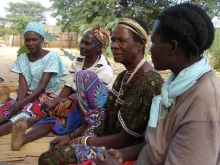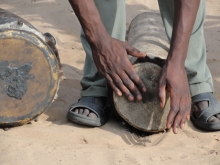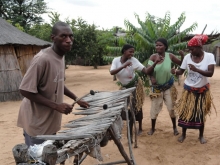History and Culture
A diverse region
The Mudumu Landscape falls within Zambezi Region, a part of Namibia unlike any other. The Region boasts 7 ethnic tribes – Subia, Yeyi, Mafwe, Totela, Mbukushu, Mbalangwe and Khwe - each with their own language. The Zambezi Region shares its borders with 4 other countries: Angola, Botswana, Zambia and Zimbabwe; and indeed the Mudumu Landscape itself borders Angola, Botswana and Zambia. The Regional capital is Katima Mulilo.
Traditional authorities
There are several levels of authority within Namibia's communal areas. In eastern Zambezi Region - including the Mudumu Landscape - each village has a headman who is the senior male of the area. He advises the senior headmen, known as the Induna, who represents a number of villages and acts as a local representative on the tribal council (Khuta) which is presided over by the Ngambela (chief councillor) and ultimately by the Chief. The Khuta is the highest legislative, administrative and judicial body in the tribal area. The Ngambela, who is appointed by the Chief, communicates the wishes of the Chief to the community through the headmen, and vice versa.
A brief timeline of the Zambezi Region
The area now known as Zambezi Region has seen a multitude of administrative changes during the last few hundred years. It has been subject to three colonial governments (Germany, Britain and South Africa) and, prior to Namibia's independence, was administered through three separate countries: Botswana, South Africa and South West Africa.
| 1600s and 1700s | First Lozi Empire, of Zambian origin. |
| 1820s - 1864 | Part of the Makololo Empire (of Sotho origin) led by Chief Sebitwane whose grave is near the village of Sangwali. They were overthrown and migrated towards Malawi. |
| 1864 - 1890 | Second Lozi Empire, led by Chief Liwanyika. |
| 1890 | The Caprivi Strip was added to German South West Africa as a result of negotiations at the Berlin Conference. This facilitated German access to the Zambezi River with the intention of providing a link to German East Africa (now Tanzania). However, Victoria Falls prevented navigation downstream. |
| 1914 - 1918 | Following the First World War, Germany was stripped of its colonial possessions and Namibia was placed under British military rule. |
| 1921 - 1939 | Administered as part of British Bechuanaland (now Botswana). |
| 1940 - 1990 | Administered by South Africa from Pretoria. From 1981, Caprivi wasadminstered under the Administration for Caprivians as part of the South West Africa Administration. |
| 1990 | Caprivi became one of the 13 political regions in Namibia with its own regional governor and six councillors. |
| 2013 | Renamed Zambezi Region. |
Sources:
- Annie Symonds, pers. comm.
- Wikipedia
- Caprivi.biz
- < href="http://www.caprivifreedom.com/history">Caprivifreedom.com
- The Cardboard Box Travel Shop
- Environmental Atlas and Profile of Caprivi, Mendelsohn, J and Roberts, C. 1997
Relevant literature
-
Bwabwata National Park - People and wildlife - a shared history
Bwabwata National Park - People and wildlife - a shared history
Bwabwata has been inhabited for millennia, but it is the more recent history that has shaped the Bwabwata National Park of today. Proclaimed in the 1960s as the Caprivi Nature Reserve, then as the Caprivi Game Park, no initial wildlife management took place because the area was a restricted security zone, occupied first by the South African police and subsequently by the South African Defence Force (SADF).» Download -
Faites vos jeux! Interests and socio-economic development in the Caprivi Region from a historical perspective
Zeller, W. 2000. Faites vos jeux! Interests and socio-economic development in the Caprivi Region from a historical perspective
» Download







